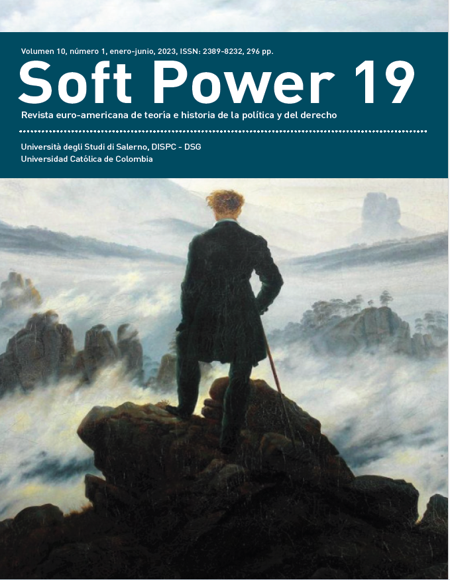
Esta obra está bajo una licencia internacional Creative Commons Atribución-NoComercial 4.0.
Al enviar los artículos para su evaluación, los autores aceptan que transfieren los derechos de publicación a Soft Power. Revista Soft Power para su publicación en cualquier medio. Con el fin de aumentar su visibilidad, los documentos se envían a bases de datos y sistemas de indización, así mismo pueden ser consultados en la página web de la Revista.Resumen
En este artículo pretendo mostrar la relevancia para la teoría social y política de algunas de las interpretaciones conceptuales de Gaia y la Zona Crítica y las conexiones de estas interpretaciones con el concepto de lo Terrestre. Estos tres conceptos desempeñan un papel clave en el “giro político” que ha caracterizado la obra teórica más reciente de Bruno Latour. El análisis se desarrolla a través de las variaciones del concepto de habitabilidad en Gaia, Zona Crítica y Terrestre, empleadas como herramienta para captar los desplazamientos semánticos del campo científico-naturalista al campo político generados por los cambios que se han producido en los últimos veinte años en la forma en que las distintas ciencias de la Vida entienden la lógica de la habitabilidad del planeta
Tierra. En el análisis se presta especial atención a las implicaciones, para la teoría social y política, que los cambios detectados con Gaia y Zona Crítica producen sobre las ideas de libertad y necesidad una vez que han salido de la dicotomía moderna naturaleza/ humanidad y sobre la lógica de los conflictos que se abren en el horizonte de la Tierra.

Citas
Ashley, G.M. (1998). Where are we headed? “Soft” rock research into the new millennium.
Geological Society of America Abstract/Program, 30, A-148.
Brantley S. L., W. H. McDowell, W. D Dietrich, T. S. White, P. Kumar, S. P. Anderson,
J. Chorover, K. A. Lohse, R. C. Bales, D. D. Richter, G. Grant & J. Gaillardet (2017).
Designing a network of critical zone observatories to explore the living skin of the
terrestrial Earth. Earth Surface Dynamics 5, 841–860.
Charbonnier, P. (2020). Where is your freedom now? How the Moderns Became Ubiq
uitous. In B. Latour & P. Weibel (Eds.), 76-79.
Dutreuil, S. (2020). Gaia Is Alive. In B. Latour & P. Weibel (Eds.), 180-183.
Gaillardet, J. (2020). The Critical Zone, a Buffer Zone, the Human Habitat. In B. Latour
& P. Weibel (Eds.), 122-129.
Latour, B. (2004). Why Has Critique Run out of Steam? From Matters of Fact to Matters
of Concern. Critical Inquiry 30 (Winter), 225-248.
Latour, B. (2005). Reassembling the Social: An Introduction to Actor-Network Theory.
Oxford University Press, 2005.
Latour, B. (2014). Some advantages of the notion of “Critical Zone” for Geopolitics.
Procedia Earth and Planetary Science, 10, 3-6.
Latour, B. (2017a). Facing Gaia. Eight Lectures on the New Climatic Regime. Polity.
Latour B. (2017b). Why Gaia is not a God of Totality. Theory, Culture & Society, Vol.
(2-3) 61–81.
Latour, B. (2018). Down to Earth. Politics in the New Climatic Regime, Cambridge: Polity.
Latour B. & Schults N. (2022). Mémo sur la nouvelle classe écologique, La Découverte.
Latour B. & Lenton T.M. (2019). Extending the domain of freedom, or why Gaia is so
hard to understand. Critical Inquiry, Vol. 45, N. 3, Spring, 659-680.
Latour B. & Weibel P. (eds) (2020). Critical Zones. The Science and Politics of Landing on
Earth. ZKM- Center for Art and Media Karlsruhe and MIT Press.
Lenton T.M. & B. Latour (2018). Gaia 2.0 - Could humans add some level of self-awareness
to Earth’s self-regulation? Science, vol. 361 (6407), 1066-1068.
Lenton T. M., S. Dutreuil & B. Latour (2020) Life on Earth is hard to spot. The Anthropocene
Review, vol. 7(3), 248-272.
Lenton T. M. & S. Dutreuil (2020a). What Exaclty is the Role of Gaia? In Latour B. and
Weibel P. (eds), 168-175.
Lenton T. M. & S. Dutreuil (2020b). Distinguishing Gaia from the Earthsystem(s). In
Latour B. & Weibel P. (eds), 176-179.
Lovelock, J. (1972). Gaia as seen through the atmosphere. Atmospheric Environment,
Vol. 6, Issue 8, August, 579-580.
Lovelock J. & L. Margulis (1974a) Homeostatic tendencies of the Earth’s atmosphere. In
Origins of Life 5, no. 1-2 (January), 93–103.
Margulis L. & J. Lovelock (1974b). Biological Modulation of the Earth’s Atmosphere.
Icarus 21, no. 4 (April), 471-89.
Turner, J. S. (2000). The Extended Organism. The Physiology of Animal-Built Structures.
Harvard University Press.
Waldron, P. (2020) Critical Zone Science Comes of Age. In EOS. Science News, vol. 101,
n. 10, october, 18-22.









